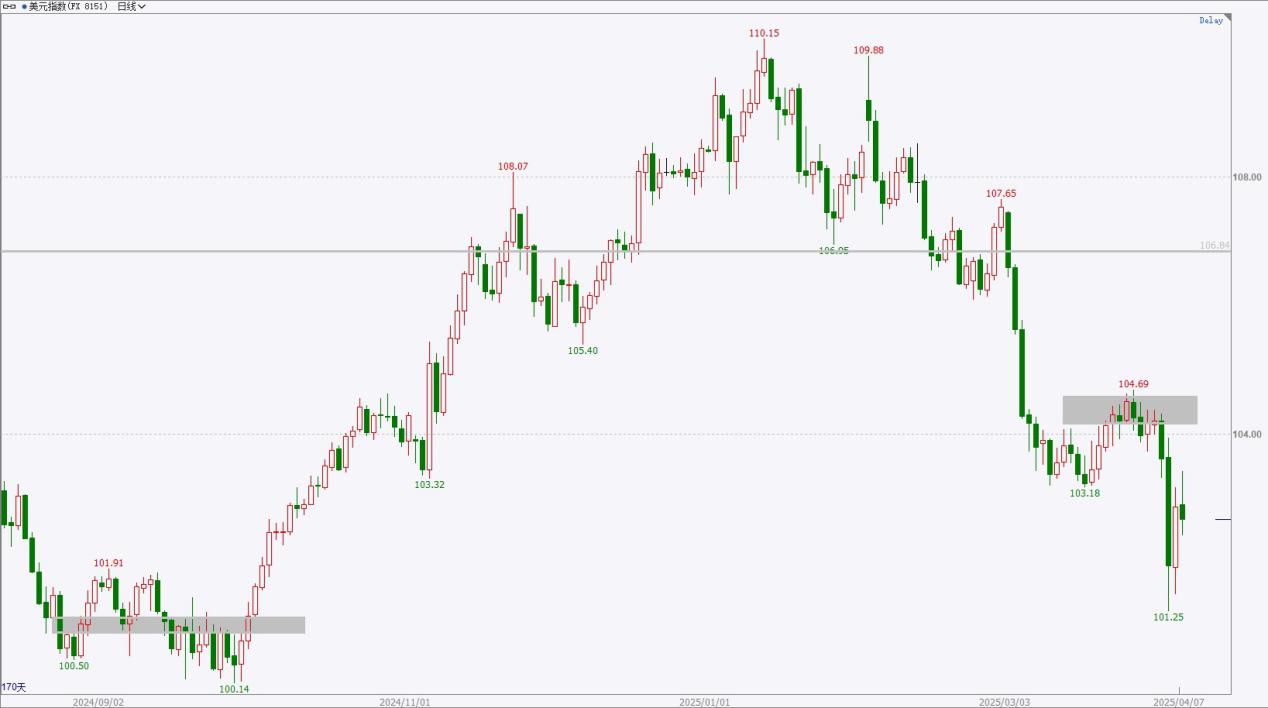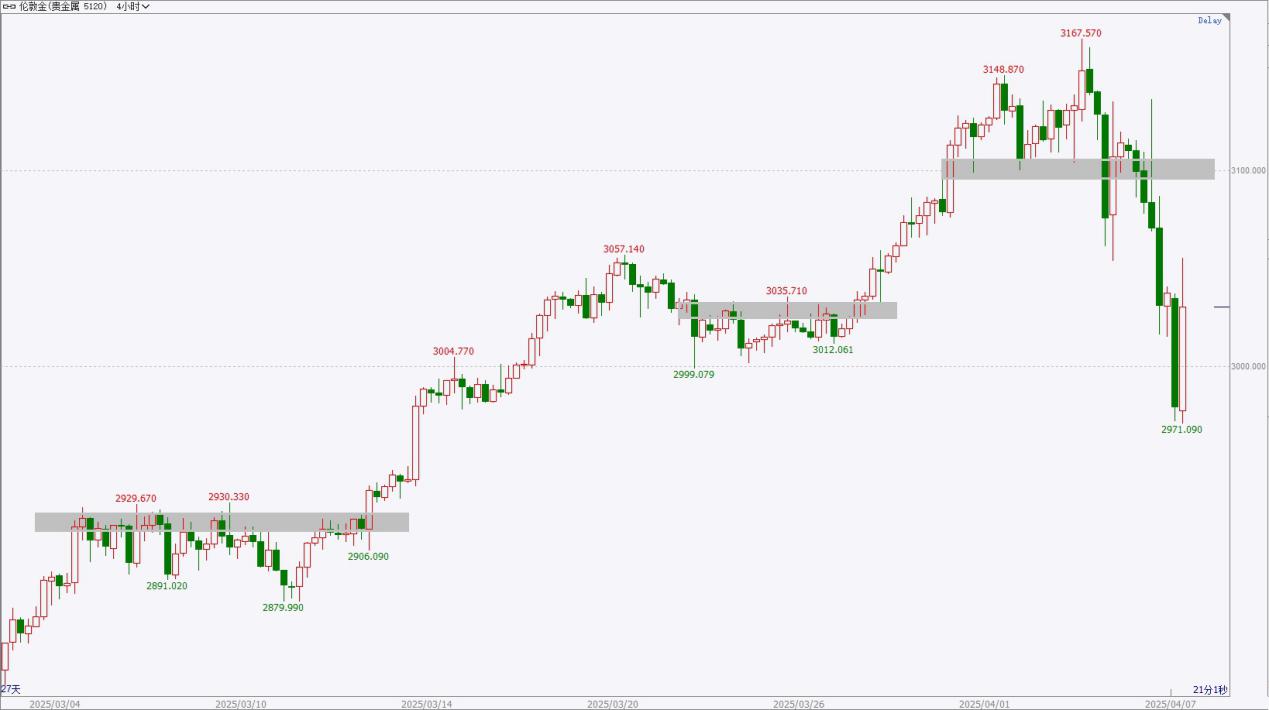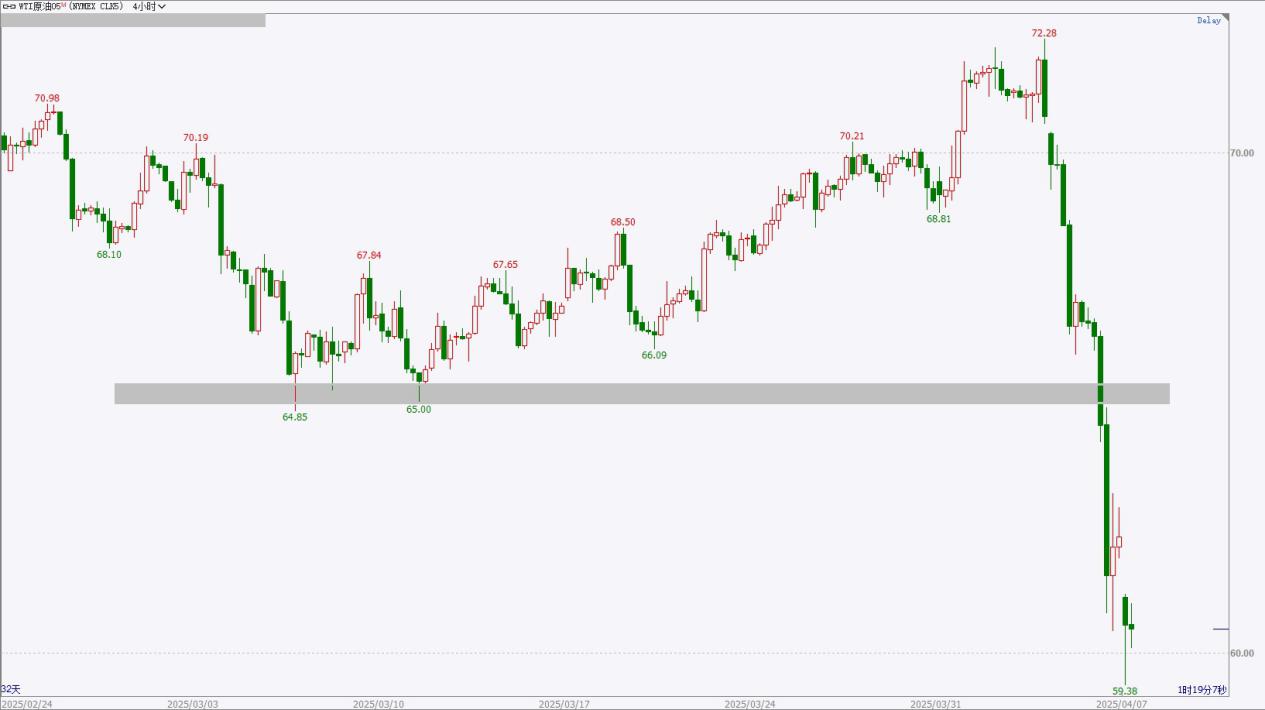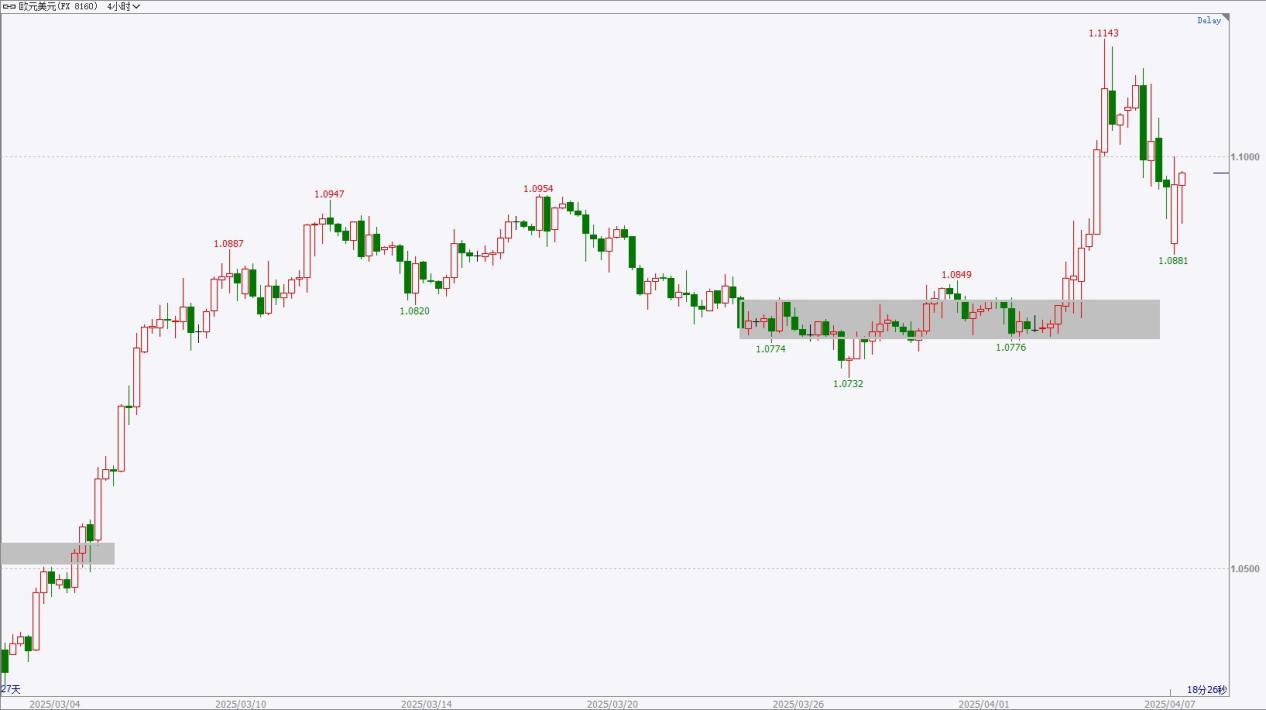|
Time
|
Data and Events
|
Importance
|
|
14:00
|
Germany’s February adjusted industrial output month-on-month change
|
★★★
|
|
Germany’s February adjusted trade balance
|
★★★
|
|
UK March Halifax adjusted house price index month-on-month change
|
★★★
|
|
16:30
|
Eurozone April Sentix investor confidence index
|
★★★
|
|
17:00
|
Eurozone February retail sales month-on-month change
|
★★★
|
|
Variety
|
Viewpoint
|
Support Range
|
Resistance Range
|
|
U.S. Dollar Index
|
Weak fluctuation
|
100-101
|
104-104.5
|
|
Gold
|
Short-term rebound
|
2900-2920
|
3100-3120
|
|
Crude Oil
|
Weak fluctuation
|
56-57
|
62-63
|
|
Euro
|
Strong fluctuation
|
1.0750-1.0800
|
1.0950-1.1000
|
*Pre-market views, possess timeliness and limitations, are based on predictions, intended for reference and learning only, do not constitute investment advice, operate at your own risk. Investment carries risks; trading requires caution.
Fundamental Analysis:
At the March Federal Reserve meeting, interest rates were maintained, the labor market remained firm, inflation expectations for the next two years were raised, and GDP growth expectations for the next three years were lowered. In April, the pace of balance sheet reduction was to be slowed, and there were uncertainties regarding tariff policies. In March, non-farm data showed an increase of 228,000 jobs, far exceeding expectations, with a slight rise in the unemployment rate indicating a strong labor market. The February unadjusted CPI year-on-year rate slightly fell short of prior values and expectations, while February core PCE price index slightly rebounded. Tariff policies increase market risks and uncertainties.
Technical Analysis:

The U.S. dollar index has recently shown weakness, experiencing daily fluctuations downward, approaching the support area below. A small cycle rebound is expected, but it does not change the weak structure; after encountering resistance above, a continuation of weakness is likely. Attention should be paid to the support structure below, as the situation may shift to fluctuation. Overall, prices are pulling back from highs, with daily fluctuations trending downward, and stabilization has yet to be observed. The upper resistance area is around 104-104.5, while the lower support area is around 100-101.
Viewpoint: Weak fluctuation with a small cycle rebound; pay attention to the upper resistance area.
*Pre-market views, possess timeliness and limitations, are based on predictions, intended for reference and learning only, do not constitute investment advice, operate at your own risk. Investment carries risks; trading requires caution.
Fundamental Analysis:
The ongoing deterioration of conflicts in the Middle East and uncertainties surrounding the Eastern European situation persist in the short term. In early March, the ECB’s interest rate decision resulted in the fifth consecutive 25 basis point cut, with inflation making progress and the economic growth risk leaning towards the downside. The March Federal Reserve interest rate decision remained unchanged, with a firm labor market leading to a downward adjustment of GDP growth expectations and a plan to slow down the balance sheet reduction. In the U.S., the unadjusted CPI year-on-year rate in February was 2.8%, slightly below expectations; in March, non-farm data showed a large exceeding of job creation expectations and a slight increase in the unemployment rate; U.S. tariff policies might stimulate gold’s hedging properties.
Technical Analysis:

Gold prices saw significant volatility last week, with daily fluctuations downward and signs of weakening. Currently, a small-level rebound is occurring, but there may be selling pressure above, so attention should be paid to the resistance area; short-term opportunities for a high sell can be considered. From a larger cycle perspective, recent substantial price increases point to a secondary pullback, with large fluctuations in the market. The upper resistance level may be around 3100-3120, while the lower support level is around 2900-2920.
Viewpoint: Short-term rebound with potential selling pressure above; pay attention to the resistance area.
*Pre-market views, possess timeliness and limitations, are based on predictions, intended for reference and learning only, do not constitute investment advice, operate at your own risk. Investment carries risks; trading requires caution.
Fundamental Analysis:
The March EIA monthly report essentially maintains the crude oil price forecast for 2025, with a slight upward adjustment in global crude oil demand growth expectations for 2026; the OPEC monthly report keeps the global crude oil demand growth forecast unchanged for this and next year; the IEA monthly report slightly lowers the global oil demand growth expectations for 2025. In early April, the OPEC+ ministerial meeting maintained its oil production policy and agreed to exceed expected production increases in May. The U.S. tariff policy suppresses global economic expectations, which may apply downward pressure on oil prices from the demand side. EIA crude oil inventories have significantly increased, and attention should be paid to changes in the supply-demand structure.
Technical Analysis:

U.S. crude oil prices fell sharply last week, showing a downward trend on a daily basis and clearly breaking below the previous low support area. The short-term performance is weak, with no signs of stabilization yet. The current price is at a relatively low level, and short positions are taking profits on dips, with a primary thinking of shorting on rebounds. Overall, the performance of crude oil prices is weak, having broken through important support levels, and there are no signs of a bottom yet. The upper pressure area is around 62-63, while the lower support area is around 56-57.
Viewpoint: The trend is slightly weak; if there are short positions, profit-taking on dips is suggested, focusing on shorting on rebounds.
*Pre-market views, possess timeliness and limitations, are based on predictions, intended for reference and learning only, do not constitute investment advice, operate at your own risk. Investment carries risks; trading requires caution.
Fundamental Analysis:
The European Central Bank’s interest rate decision in early March saw a continuous fifth cut of 25 basis points, with satisfactory progress in inflation decline, slightly lowering the GDP growth forecasts for this and next year. The risk of economic growth is tilted downward, and tariffs may have negative impacts. In March, the Federal Reserve’s interest rate decision remained unchanged while raising inflation expectations and lowering GDP growth forecasts, indicating a slowdown in balance sheet reduction efforts. The U.S. March non-farm data showed new job creation significantly exceeding expectations, and the unemployment rate saw a slight increase. In the Eurozone and economies like France and Germany, the manufacturing PMI values were slightly better than previous and expected values.
Technical Analysis:

The euro surged and then fell back last week, with the short-term performance still skewed towards strength. Currently, it is in a small cycle correction, and after stabilizing, it may continue to rise, with a focus on buying on dips and taking profits on highs. Overall, after a significant increase in the previous trend, there are signs of a bottom after a short-term correction, which may restore the upward trend. The upper pressure area is around 1.0950-1.1000, while the lower minor support area is around 1.0750-1.0800.
Viewpoint: The trend is slightly strong, with a small cycle correction; pay attention to stabilization signals.
*Pre-market views, possess timeliness and limitations, are based on predictions, intended for reference and learning only, do not constitute investment advice, operate at your own risk. Investment carries risks; trading requires caution.


Daily Reviews
Our award-winning team of analysts provides keen and insightful technical and fundamental analysis to understand daily market news and investment trading opportunities
HTFX Daily Forex Commentary 0407
Time
Data and Events
Importance
14:00
Germany’s February adjusted industrial output month-on-month change
★★★
Germany’s February adjusted trade balance
★★★
UK March Halifax adjusted house price index month-on-month change
★★★
16:30
Eurozone April Sentix investor confidence index
★★★
17:00
Eurozone February retail sales month-on-month change
★★★
Variety
Viewpoint
Support Range
Resistance Range
U.S. Dollar Index
Weak fluctuation
100-101
104-104.5
Gold
Short-term rebound
2900-2920
3100-3120
Crude Oil
Weak fluctuation
56-57
62-63
Euro
Strong fluctuation
1.0750-1.0800
1.0950-1.1000
*Pre-market views, possess timeliness and limitations, are based on predictions, intended for reference and learning only, do not constitute investment advice, operate at your own risk. Investment carries risks; trading requires caution.
Fundamental Analysis:
At the March Federal Reserve meeting, interest rates were maintained, the labor market remained firm, inflation expectations for the next two years were raised, and GDP growth expectations for the next three years were lowered. In April, the pace of balance sheet reduction was to be slowed, and there were uncertainties regarding tariff policies. In March, non-farm data showed an increase of 228,000 jobs, far exceeding expectations, with a slight rise in the unemployment rate indicating a strong labor market. The February unadjusted CPI year-on-year rate slightly fell short of prior values and expectations, while February core PCE price index slightly rebounded. Tariff policies increase market risks and uncertainties.
Technical Analysis:
The U.S. dollar index has recently shown weakness, experiencing daily fluctuations downward, approaching the support area below. A small cycle rebound is expected, but it does not change the weak structure; after encountering resistance above, a continuation of weakness is likely. Attention should be paid to the support structure below, as the situation may shift to fluctuation. Overall, prices are pulling back from highs, with daily fluctuations trending downward, and stabilization has yet to be observed. The upper resistance area is around 104-104.5, while the lower support area is around 100-101.
Viewpoint: Weak fluctuation with a small cycle rebound; pay attention to the upper resistance area.
*Pre-market views, possess timeliness and limitations, are based on predictions, intended for reference and learning only, do not constitute investment advice, operate at your own risk. Investment carries risks; trading requires caution.
Fundamental Analysis:
The ongoing deterioration of conflicts in the Middle East and uncertainties surrounding the Eastern European situation persist in the short term. In early March, the ECB’s interest rate decision resulted in the fifth consecutive 25 basis point cut, with inflation making progress and the economic growth risk leaning towards the downside. The March Federal Reserve interest rate decision remained unchanged, with a firm labor market leading to a downward adjustment of GDP growth expectations and a plan to slow down the balance sheet reduction. In the U.S., the unadjusted CPI year-on-year rate in February was 2.8%, slightly below expectations; in March, non-farm data showed a large exceeding of job creation expectations and a slight increase in the unemployment rate; U.S. tariff policies might stimulate gold’s hedging properties.
Technical Analysis:
Gold prices saw significant volatility last week, with daily fluctuations downward and signs of weakening. Currently, a small-level rebound is occurring, but there may be selling pressure above, so attention should be paid to the resistance area; short-term opportunities for a high sell can be considered. From a larger cycle perspective, recent substantial price increases point to a secondary pullback, with large fluctuations in the market. The upper resistance level may be around 3100-3120, while the lower support level is around 2900-2920.
Viewpoint: Short-term rebound with potential selling pressure above; pay attention to the resistance area.
*Pre-market views, possess timeliness and limitations, are based on predictions, intended for reference and learning only, do not constitute investment advice, operate at your own risk. Investment carries risks; trading requires caution.
Fundamental Analysis:
The March EIA monthly report essentially maintains the crude oil price forecast for 2025, with a slight upward adjustment in global crude oil demand growth expectations for 2026; the OPEC monthly report keeps the global crude oil demand growth forecast unchanged for this and next year; the IEA monthly report slightly lowers the global oil demand growth expectations for 2025. In early April, the OPEC+ ministerial meeting maintained its oil production policy and agreed to exceed expected production increases in May. The U.S. tariff policy suppresses global economic expectations, which may apply downward pressure on oil prices from the demand side. EIA crude oil inventories have significantly increased, and attention should be paid to changes in the supply-demand structure.
Technical Analysis:
U.S. crude oil prices fell sharply last week, showing a downward trend on a daily basis and clearly breaking below the previous low support area. The short-term performance is weak, with no signs of stabilization yet. The current price is at a relatively low level, and short positions are taking profits on dips, with a primary thinking of shorting on rebounds. Overall, the performance of crude oil prices is weak, having broken through important support levels, and there are no signs of a bottom yet. The upper pressure area is around 62-63, while the lower support area is around 56-57.
Viewpoint: The trend is slightly weak; if there are short positions, profit-taking on dips is suggested, focusing on shorting on rebounds.
*Pre-market views, possess timeliness and limitations, are based on predictions, intended for reference and learning only, do not constitute investment advice, operate at your own risk. Investment carries risks; trading requires caution.
Fundamental Analysis:
The European Central Bank’s interest rate decision in early March saw a continuous fifth cut of 25 basis points, with satisfactory progress in inflation decline, slightly lowering the GDP growth forecasts for this and next year. The risk of economic growth is tilted downward, and tariffs may have negative impacts. In March, the Federal Reserve’s interest rate decision remained unchanged while raising inflation expectations and lowering GDP growth forecasts, indicating a slowdown in balance sheet reduction efforts. The U.S. March non-farm data showed new job creation significantly exceeding expectations, and the unemployment rate saw a slight increase. In the Eurozone and economies like France and Germany, the manufacturing PMI values were slightly better than previous and expected values.
Technical Analysis:
The euro surged and then fell back last week, with the short-term performance still skewed towards strength. Currently, it is in a small cycle correction, and after stabilizing, it may continue to rise, with a focus on buying on dips and taking profits on highs. Overall, after a significant increase in the previous trend, there are signs of a bottom after a short-term correction, which may restore the upward trend. The upper pressure area is around 1.0950-1.1000, while the lower minor support area is around 1.0750-1.0800.
Viewpoint: The trend is slightly strong, with a small cycle correction; pay attention to stabilization signals.
*Pre-market views, possess timeliness and limitations, are based on predictions, intended for reference and learning only, do not constitute investment advice, operate at your own risk. Investment carries risks; trading requires caution.
Latest Reviews
HTFX Daily Forex Commentary 0819
HTFX Daily Forex Commentary 0815
HTFX Daily Forex Commentary 0812
HTFX Daily Forex Commentary 0811
Choose a Trusted Broker for Trading
Over 300 employees worldwide, more than 1,000 products, top-tier liquidity